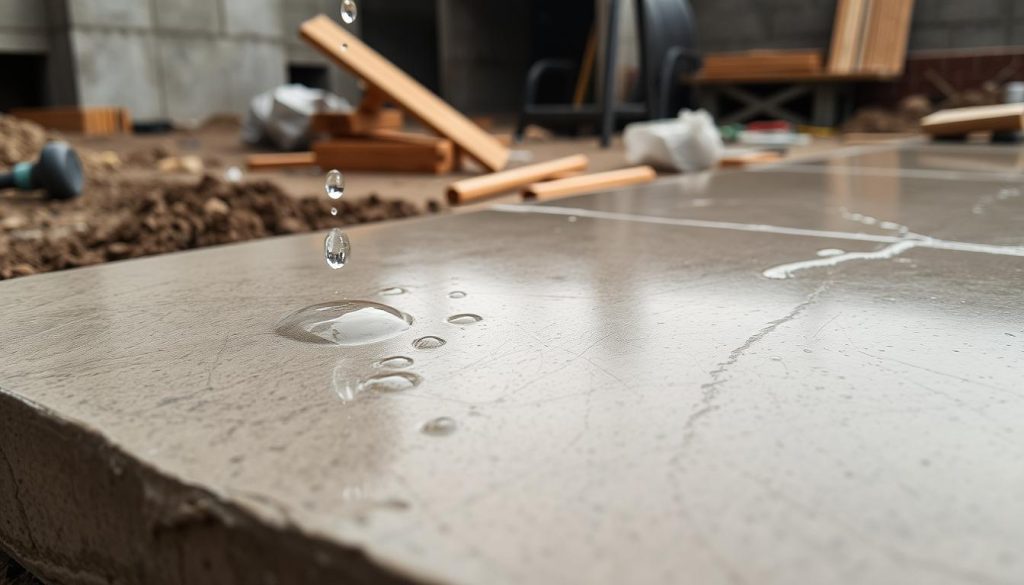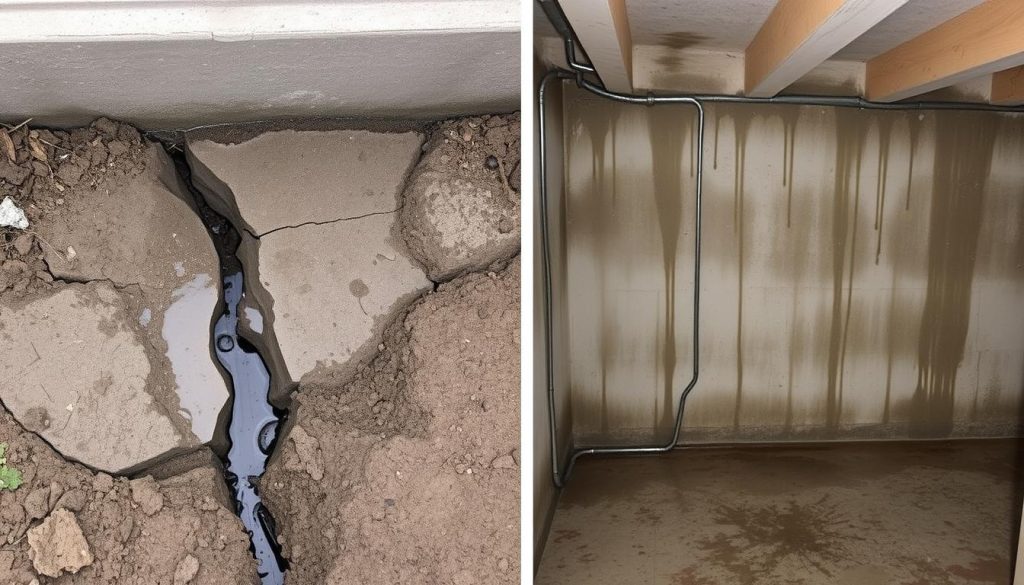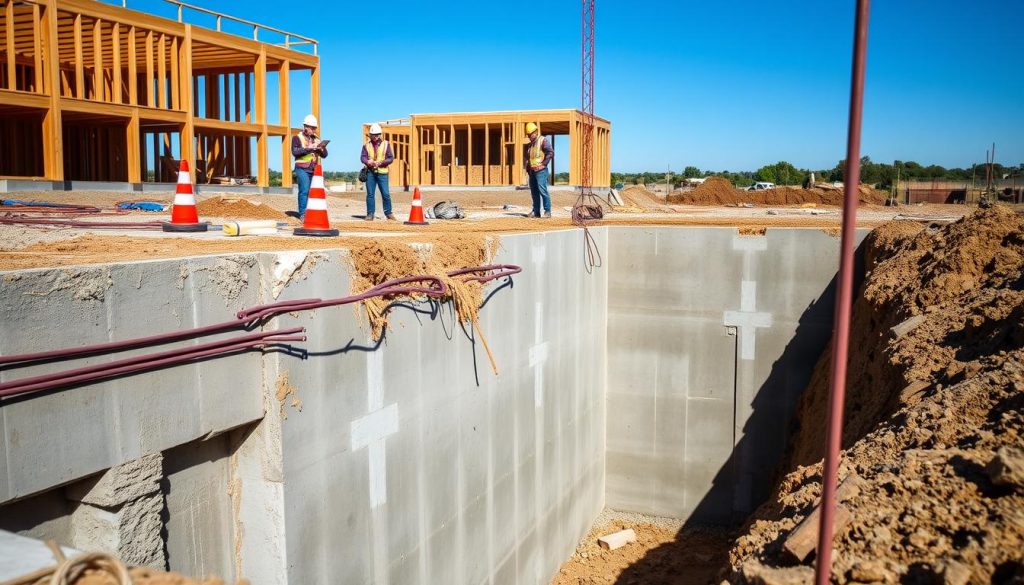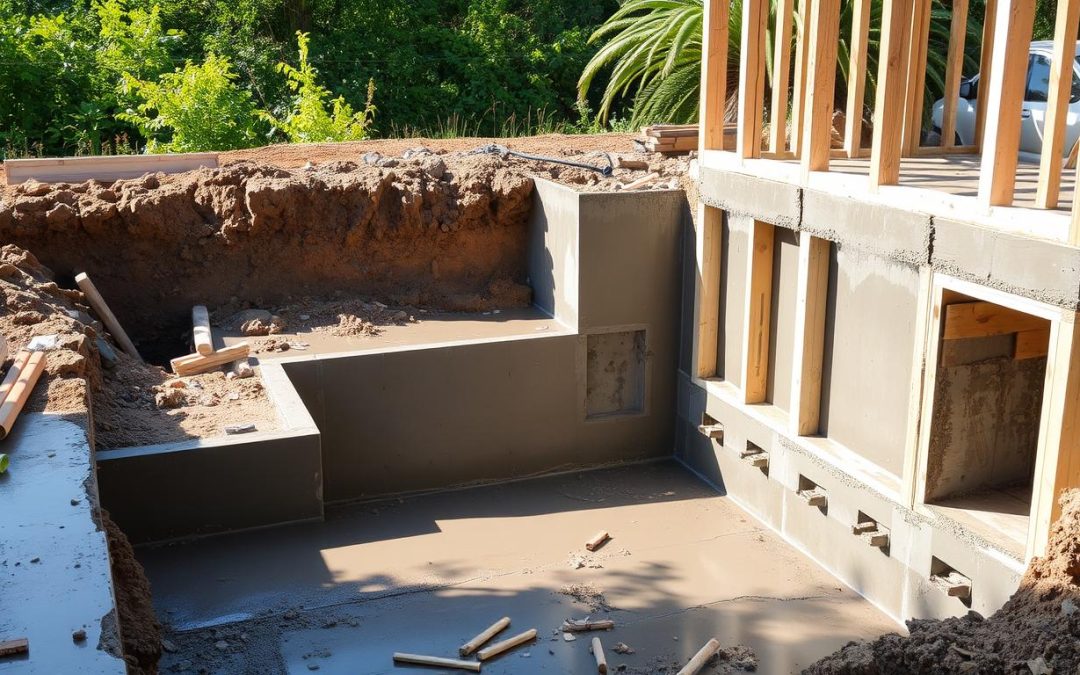Concrete is key for strong and lasting structures. It’s vital for foundations and basements to keep buildings safe and sound. The right concrete can save you from expensive fixes and keep everyone safe.
Knowing how important concrete is for foundations and basements is essential. High-quality concrete helps build a solid base. This prevents problems like cracks and water damage.
Introduction to Concrete Foundations
In the U.S., concrete is a must for foundations and basements. By using the best materials and following best practices, you can make your building last. The right concrete helps your building stand up to harsh weather and lasts for years.
Key Takeaways
- Concrete for foundations & basements is essential for structural integrity
- Foundation concrete and basement concrete must be of high quality
- Properly laid concrete can prevent costly repairs
- Concrete for foundations & basements can help prevent issues like cracks and water damage
- Following best practices is critical for a successful construction project
- High-quality foundation concrete and basement concrete ensure buildings last long
Understanding Concrete for Foundations & Basements
Choosing the right concrete for foundations and basements is key for their strength and longevity. Reinforced concrete stands out because it’s strong and less likely to crack. Knowing the different types of concrete is vital for a solid foundation.
Concrete is classified by its strength, measured in pounds per square inch (PSI). For foundations and basements, there are three main types:
- Normal-weight concrete: This concrete weighs about 145 pounds per cubic foot. It’s perfect for most foundation and basement needs.
- Structural lightweight concrete: With a weight of around 100 pounds per cubic foot, it’s used for foundations and basements needing less weight.
- High-strength concrete: This concrete has a strength over 6,000 PSI. It’s ideal for foundations and basements needing top-notch strength and durability.
The mix of cement, water, and aggregates in concrete is also important. Reinforced concrete is often chosen for its added strength and stability in foundations and basements.
Types of Foundation Concrete
There are many types of foundation concrete, each with its own benefits. Knowing these types helps choose the best concrete for your project.
Strength Requirements and Classifications
Concrete strength is measured in PSI. The most common classifications for foundation and basement concrete are:
Chemical Composition and Properties
The mix of cement, water, and aggregates in concrete is critical. It determines the concrete’s strength and durability.
Essential Site Preparation Steps
Getting the site ready is key for durable concrete foundations and basements. First, clear the area of debris. Then, dig to the right depth and level it out. This solid base is vital for your structure’s long-term stability.
A well-prepared site avoids problems like uneven settling and water damage. To do this, follow important site preparation steps. These include:
- Clearing the land of trees, rocks, and other obstacles
- Excavating to the correct depth and width
- Compacting the soil to prevent settling
- Laying a sturdy base for the durable concrete foundation
By doing these steps, you get a strong, durable concrete foundation that lasts. The American Concrete Institute says, “proper site preparation is essential for the successful construction of a concrete foundation.”
Remember, a well-prepared site is the foundation of a successful concrete project. By preparing the site well, you ensure a strong, durable concrete foundation. This will support your structure for many years.
Selecting the Right Concrete Mix
Choosing the right concrete mix is key for a strong foundation or basement. The right mix helps the concrete last long and handle different weather conditions. You need to think about the water-cement ratio, the type of aggregate, and what additives to use.
The water-cement ratio is very important for the concrete’s strength and durability. A lower ratio means stronger concrete, while a higher ratio means weaker concrete. Also, the type and size of the aggregates, like sand or gravel, affect the concrete’s workability and strength.
Key Considerations for Concrete Mix Selection
- Water-cement ratio: A lower ratio can result in stronger and more durable structural concrete.
- Aggregate selection: The type and size of the aggregates can affect the workability, strength, and durability of the concrete.
- Admixture considerations: Admixtures can be used to enhance the properties of the structural concrete, such as its workability, strength, and durability.
By carefully choosing the right concrete mix, builders can make sure their project lasts. The right mix gives the concrete the strength and durability it needs. It also helps it resist weather changes, making the structure safe and stable. Whether it’s a new home or a renovation, picking the right concrete mix is vital.
Reinforcement Techniques and Materials
Reinforcing concrete foundations and basements is key to their durability. Reinforcement techniques add strength and longevity to these structures. Rebar, a steel bar or mesh of wires, is a common reinforcement material.
Several reinforcement techniques are used in concrete foundations and basements. These include:
- Using rebar to provide tensile strength
- Adding fibers to the concrete mix to improve durability
- Implementing post-tensioning systems to reduce cracking
These reinforcement techniques help distribute weight and stress evenly. This reduces the risk of cracking and damage. By using these techniques, builders create stronger, more durable foundations and basements.
Choosing the right reinforcement materials and techniques is vital. Factors like soil type, climate, and structure use must be considered. This ensures that foundations and basements are strong and last long.
Proper Concrete Pouring Methods
Pouring concrete for a slab foundation needs careful planning and execution. It’s important to pay attention to details, like temperature and equipment, for a successful pour. This ensures a strong and durable slab foundation.
The success of a concrete pour depends on timing, scheduling, and the right equipment. Temperature considerations are key. Extreme temperatures can change how well the concrete sets and lasts.
Temperature Considerations
Concrete should be poured when it’s between 40°F and 90°F (4°C and 32°C). This range is best for setting and curing. Pouring in extreme temperatures can cause problems like weaker strength and less durability.
Timing and Scheduling
Timing and scheduling are very important for pouring concrete. The pour should avoid bad weather like heavy rain or direct sunlight. It should also be done quickly to prevent cold joints and ensure a smooth finish.
By using the right methods for pouring concrete, considering temperature, timing, and equipment, you can get a strong slab foundation. This will last for many years.
Waterproofing and Moisture Control
Waterproofing is key to stopping moisture problems in foundations and basements. Waterproof concrete plays a big role in this. It stops water from getting into the structure. There are many ways to waterproof, like using membranes and coatings.
Some main ways to waterproof include:
- Using waterproof concrete to prevent water from seeping into the structure
- Applying waterproof membranes to the exterior of the foundation or basement walls
- Coating the interior surfaces with a waterproof sealant
Using waterproof concrete in foundations and basements is also important. This concrete is made to keep water out. It helps avoid moisture problems. With waterproof concrete and other methods, homes stay safe from water damage.

It’s not just about the concrete. Making sure the foundation or basement drains well is also key. French drains or other systems can help. These steps keep moisture away and foundations dry and safe.
Curing and Protection Measures
After pouring, concrete foundations and basements need the right care to be strong and last long. A skilled concrete contractor is key to making sure this happens. They help keep the concrete at the right temperature and moisture levels. This helps the concrete get stronger.
It’s important to keep the concrete at a temperature between 50°F and 70°F. Also, it should stay moist for a while. A concrete contractor can use special products on the concrete’s surface. This helps keep moisture in and ensures even curing.
Optimal Curing Conditions
- Maintaining a consistent temperature between 50°F and 70°F
- Keeping the concrete moist for an extended period
- Applying specialized curing compounds to the surface of the concrete
Protecting the concrete from harsh weather is also important. A concrete contractor can protect it from too much sun, heavy rain, and extreme temperatures. By following these steps, homes can have strong and lasting concrete foundations and basements. A professional concrete contractor can help make this happen.
Common Problems and Solutions
Concrete foundations and basements can face common issues. These include cracks, settlement problems, and moisture challenges. It’s key to spot and fix these problems to keep the structure stable and long-lasting.
Common issues with concrete foundations and basements include cracks in walls and floors. There are also settlement issues that cause uneven surfaces. And, moisture-related challenges can lead to mold and water damage. Knowing the causes and finding good solutions is essential.
Prevention and Solutions
To avoid common problems, follow good construction and maintenance practices. Make sure the foundation is built on a solid base. Use quality materials and check the structure regularly for damage. These steps can save you from expensive repairs and keep your foundation and basement safe.

Addressing Common Issues
If common problems happen, fix them quickly and well. This might mean repairing cracks, adjusting the foundation, or controlling moisture. A proactive maintenance and repair approach can protect your investment and keep your foundation and basement in top shape.
Understanding and tackling common problems can make your living space safe and secure. Regular checks and maintenance can spot issues early. This saves time and money in the long run.
Maintenance and Long-term Care
Keeping your concrete foundations and basements in good shape is key. Regular checks can spot problems early. It’s wise to inspect them yearly for cracks, water damage, or other issues.
When you inspect, pay attention to:
- Cracks in the walls and floors
- Water damage or leaks
- Settlement issues or uneven floors
- Signs of pest or rodent infestation
Preventive steps can also help avoid problems. Make sure water drains away from the foundation. Seal any cracks or gaps. And keep the basement dry and well-ventilated. These actions help keep your foundation and basement stable for years.
Regular inspections and care can make your concrete last longer. This saves you time and money. Also, keep records of your inspections and maintenance. This helps track any changes or issues over time.
Building Code Compliance and Permits
Following local building codes is key for safe and legal foundation and basement construction. Building code compliance means structures can handle weather, earthquakes, and floods. It’s important for homeowners and builders to avoid fines and safety risks.
To follow building code compliance, you need to get the right permits first. You must send detailed plans to local authorities for approval. They check if the plans meet the standards.
- Submitting plans and specifications for review and approval
- Obtaining necessary permits and licenses
- Scheduling inspections to verify compliance
During building, there are regular checks to make sure everything is up to code. This includes looking at foundation depth and wall thickness. Keeping records of permits and inspections is also important.

By focusing on building code compliance and getting permits, you ensure your foundation and basement are safe. This protects your investment and gives you peace of mind.
Conclusion: Ensuring Success in Your Concrete Foundation Project
Starting your concrete foundation and basement project? Remember, careful planning and proper execution are key. This guide has covered the basics of working with concrete. It includes understanding types and properties, and mastering site preparation, pouring, and curing.
By using the insights from this guide, you can create durable, safe foundations. These foundations will last a long time. Whether you’re a homeowner, builder, or contractor, keep these best practices in mind. This will help you avoid common mistakes and achieve your goals.
As you continue, always consult with experienced professionals. Follow local building codes and maintain your foundation well. This way, you’ll ensure your project’s success and longevity. You’ll create a strong foundation for your home or building.

